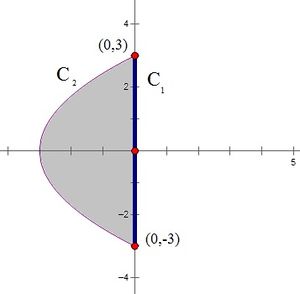Science:Math Exam Resources/Courses/MATH105/April 2014/Question 04 (b)
{{#incat:MER QGQ flag|{{#incat:MER QGH flag|{{#incat:MER QGS flag|}}}}}}
• Q1 (a) • Q1 (b) • Q1 (c) • Q1 (d) • Q1 (e) • Q1 (f) • Q1 (g) • Q1 (h) • Q1 (i) • Q1 (j) • Q1 (k) • Q1 (l) • Q1 (m) • Q1 (n) • Q2 (a) • Q2 (b) • Q2 (c) • Q3 (a) • Q3 (b) • Q4 (a) • Q4 (b) • Q5 (a) • Q5 (b) • Q6 (a) • Q6 (b) •
Question 04 (b) |
|---|
|
Let . Find the maximum and minimum values of on the region . |
|
Make sure you understand the problem fully: What is the question asking you to do? Are there specific conditions or constraints that you should take note of? How will you know if your answer is correct from your work only? Can you rephrase the question in your own words in a way that makes sense to you? |
|
If you are stuck, check the hints below. Read the first one and consider it for a while. Does it give you a new idea on how to approach the problem? If so, try it! If after a while you are still stuck, go for the next hint. |
Hint 1 |
|---|
|
Sketch the region and check the local max, local min, and points on the boundary. |
Hint 2 |
|---|
|
On the boundary, transform the function to the one with only one variable and then differentiate it to find the minimum and maximum. |
|
Checking a solution serves two purposes: helping you if, after having used all the hints, you still are stuck on the problem; or if you have solved the problem and would like to check your work.
|
{{#incat:MER CT flag||
}}








![{\displaystyle C_{1}=\{x=0,y\in [-3,3]\},}](https://wiki.ubc.ca/api/rest_v1/media/math/render/svg/e0f9b20aa0fea7140e8c2f4a61787923f6e98e33)



![{\displaystyle [-3,3]}](https://wiki.ubc.ca/api/rest_v1/media/math/render/svg/3a869f6f7ff84a95f888c6b8705e2465ba21960e)



![{\displaystyle C_{2}=\{x={\frac {1}{3}}y^{2}-3,y\in [-3,3]\},}](https://wiki.ubc.ca/api/rest_v1/media/math/render/svg/28ede10138e95194f9d75dcd092280e8d5037796)










